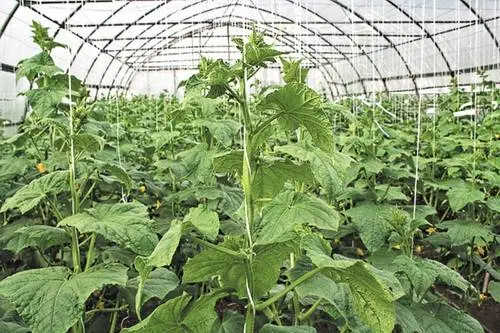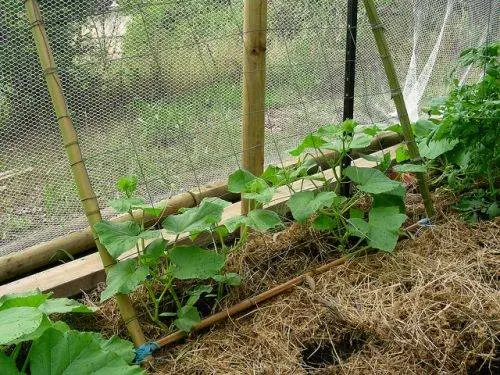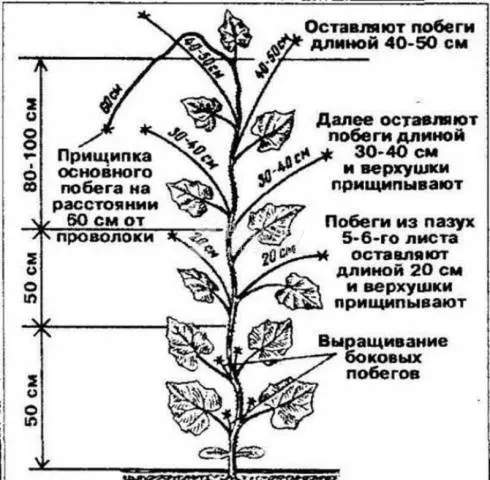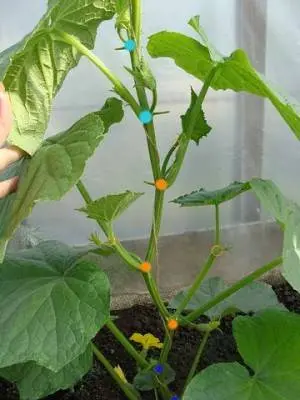Contents
Forming cucumbers in a greenhouse, shaping a bush and controlling shoot growth are all elements of caring for the most popular vegetable plant. Cucumber is a fast growing vine. In order to get a good harvest, it is necessary to constantly direct the growth of shoots in the right direction, to encourage the plant to concentrate its forces on fruit ripening.

Formation of cucumber vine
The cucumber bush is an annual vine that, under favorable conditions, is capable of developing very long and branched shoots. For the humid tropics, this may be fine, but where the growing season lasts 6-7 months, building green mass is not always necessary.
The formation of cucumbers in a polycarbonate greenhouse is an optimization of the structure of the entire vine in order to increase productivity.
In order for the cucumbers not to leave the leaves, but to bloom and bear fruit as actively as possible, it is necessary to follow these rules:
- Periodically remove everything that does not work for the crop.
- The placement of bushes should be as rational as possible.
- Cucumbers in a polycarbonate greenhouse can give a decent harvest only if they trail along the trellises.
- With the help of a rational pinching and pruning scheme, the cucumber bush is given the desired direction of growth due to the requirements of illumination, branching and growth restriction.

It is necessary to remove, first of all, leaves that are in deep shade – they do not fully carry out photosynthesis, but at the same time take away water and minerals. The lowest leaves are also subject to removal; leaves and shoots that begin to wither and turn yellow. Finally, mustaches and male flowers are often categorized as superfluous and unnecessary. This question is debatable, but worthy of attention.
The most rational placement of bushes means that the formation of cucumbers in a polycarbonate greenhouse significantly depends on the abundance of sunlight and the duration of its exposure to all parts of the cucumber vine. The formation of the bush must be done in such a way as to provide maximum illumination with a minimum of space occupied.
You can do without tapestries only with excess space and the temporary nature of the use of land.

Thus, the formation of a cucumber lash is a set of measures to remove excess and optimize the placement of shoots relative to the light source. Everything else is in the nature of secondary actions.
Rules for trimming and pinching
The fundamental difference between pruning and pinching is the radical effect. In the first case, we are talking about removing part of the whip, leaves, fruits, flowers and mustaches. In the second – most often about the removal of a growth point on the main or side shoot. Pruning and pinching are the main methods aimed at shaping the bush.

The scheme for trimming and pinching consists in the following actions:
- At the stage of the appearance of the first 6 leaves, you need to pinch off the top of the shoot. This encourages the plant to branch further, which increases yield. If time is lost and the vines are already large, then pinching is pointless – this will only lead to inhibition of growth.
- Removal of excess whiskers and male flowers. If you have chosen the strategy of carefully hand-tying all the whips, then the mustache, of course, needs to be trimmed. However, you should not remove all the male flowers – pollen must be taken from somewhere to fertilize the female flowers.
- Some leaves from cucumbers in the greenhouse must be removed.
- If you are not going to leave cucumbers for seeds, then remove all overripe fruits immediately. Continuing to mature, they will take on resources.
The strategy for the formation of cucumbers in a polycarbonate greenhouse depends on your desire, ideas about the feasibility and features of the greenhouse design. This is especially due to the allowable length of the whip. If the liana is too long, it can be cut or bent down, where it would fill the voids of the lower floors of the trellis.
Optimizing the placement of creepers in space
In order to understand how to properly form cucumbers, it is not necessary to focus on widespread pruning and pinching. Sometimes you need to let the plant have what at first glance is superfluous. It’s about the mouth. Growing cucumbers with mustaches can be not only acceptable, but even profitable. It all depends on the strategy you choose to place the bushes in the greenhouse.

The presence or absence of a mustache makes its own adjustments to the process of formation of cucumber bushes. However, regardless of how you decide to grow vines, you must follow the following rules:
- Once every 1 days, you need to check the position of the shoots and tie up the falling lashes.
- With the same regularity, you should wrap the shoot around the twine clockwise. After all, this is exactly what the vine does in natural conditions. The tip of any shoot must be free, since this is where the growth point is located. Twisting occurs with the help of that part of the shoot that is about 5 cm below the top.
- When we form whips with a mustache, the process is simplified and complicated at the same time. During the period of active growth, vines with the help of a mustache will form themselves, actively clinging to everything that turns up. However, this is good only if the landings are sufficiently sparse, and the trellises are well equipped with thick wire weaves. Otherwise, someday you will find that everything is tangled and messed up.
Of course, everyone has their own answer to the question of how to form cucumbers in a greenhouse. The gardener himself decides how to grow cucumbers – with or without a mustache, sparse or thickened as much as possible, with high and complex trellises or with single twine. However, it is highly desirable to know the basic rules for the formation of cucumbers in a polycarbonate greenhouse, which have absorbed the experience of more than one generation of farmers.









